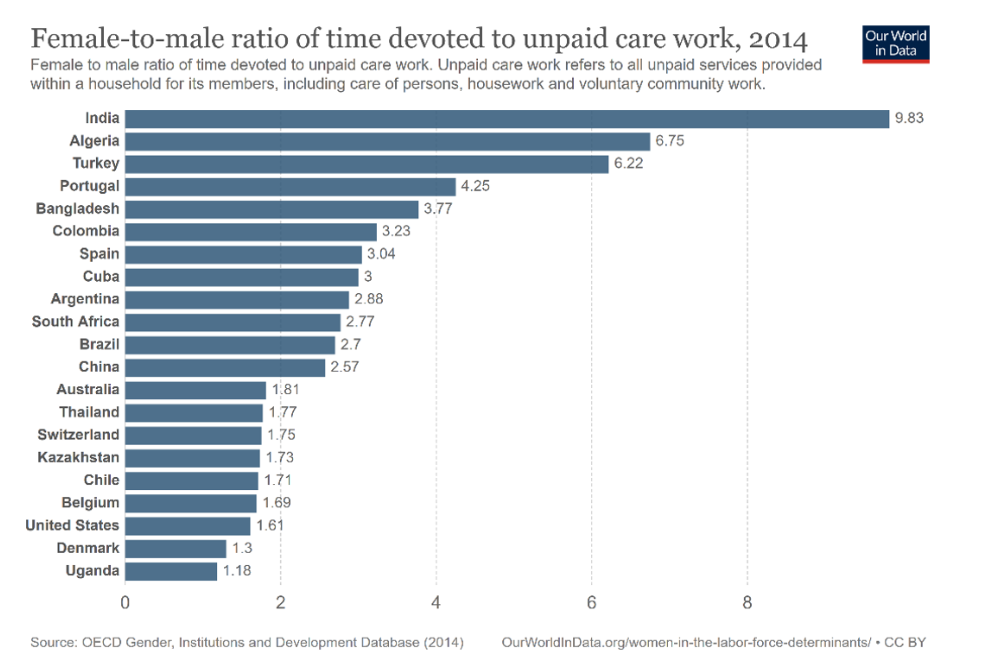
What factors underlie the persistently low labour force participation rates of Indian women?
Editor's note: This article originally appeared on VoxEU.
The Indian growth and development story since 1991 presents several paradoxes. The economy has experienced high rates of growth, reduced poverty, and witnessed improvement in several indicators. These include an impressive decline in maternal mortality, a steady increase in women’s education levels leading to a consequent reduction in gender gaps in educational attainment, and a reduction in fertility levels to replacement levels. However, while elsewhere in the world these positive trends are associated with a rise in women’s participation in paid work, this has not materialised in India.
One possibility for why India may have failed to realise an increase in female labour force participation could be entrenched patriarchal social norms. The most obvious manifestation of these norms are the ‘missing women’ that have attracted a great deal of scholarly attention, most notably in the context of India and China (Sen 1990, 1992). This ‘missing women’ phenomena refers to a highly skewed sex ratio at birth, due to practices like sex-selective abortion, female foeticide, and infanticide, and reflects a strong son preference. In societies with such strong son preference, it would be natural to expect these attitudes to not only shape gender gaps in various dimensions including labour force participation rates, mobility, autonomy, and independent decision-making ability, but also to draw open or tacit support from women, even when their lives are adversely impacted.
To the extent that norms matter, it is also important to explore whether these all directly map onto labour market inequalities or whether only some prove to be binding constraints on female participation. Moreover, the stickiness of these norms will be a key determinant of whether the root cause of low particption can be addressed. Often, issues on gender inequalities are more complex than they appear at first sight (Ray and Anderson 2015)
The mainstream view on India’s historically low female labour force participation rate (FLFPR), which did not surpass 50% even at its highest level, is dominated by supply-side explanations. Chief reasons include conservative social norms resulting in low female mobility and autonomy, concern for safety due to fear of street violence, sexual harassment, and unwillingness to defy tradition.
Our study
Using data from a primary survey conducted in the eastern state of West Bengal, India, in Deshpande and Kabeer (2024) we show that standard labour force surveys underestimate women’s contribution to paid work. Family enterprises, the main source of household livelihood, rely on the free labour provided by women. This work often goes unnoticed and unrecognised, leading to underreporting by both men and women. We call this ‘expenditure-saving’ work because without women’s contributions of time and labour, these enterprises would need to hire workers. We show that a slight change in the labour force survey questionnaire, in response to this issue, can reveal the true extent of women’s involvement in economic work. However, correcting for undercounting does not eliminate the need for integrating women into paid work, as they are neither remunerated nor recognised as workers for these unpaid contributions.
In addition to this unpaid economic work, Indian women are primarily responsible for domestic chores including cooking, gathering fuel, laundry, house maintenance, and caring for children and the elderly. The gender gap in time spent on these activities in India is one of the highest globally, with Indian women spending ten times as much time on these tasks as men. We argue that these are the ‘norms that matter,’ preventing women from pursuing paid work unless it is close to their homes.
Figure 1

Source: Our World in Data, Ortiz-Ospina and Tzvetkova (2017).
Similar to other national surveys, our survey revealed unmet demand for (paid) work on the part of women who are currently out of the labour force, with 19% expressing a preference for regular full-time work, 8% for regular part-time work, 68% for occasional full-time work, and 6% for occasional part-time work. This shows that women want to be in paid work as long as work is at or near their homes. Moreover, we found evidence of a positive intergenerational transmission of norms: women whose mothers or mothers-in-law had been in paid employment were more likely to be in the labour force after controlling for all standard factors.
In a separate paper (Deshpande et al. 2023), we show that whilst India’s female labour force participation rate has been declining, women’s enrolment in rural self-help groups (SHGs) has been rising to stand at over 75 million women. In the paper, we combine administrative data on SHG membership across districts in India with survey micro-data on the labour force and employment outcomes of rural women between 2011 and 2019. We find that SHG membership is positively associated with labour force participation and employment of rural women. We also find evidence that SHG membership is associated with a shift towards self-employment and a crowding-out of casual work among the employed. Our supplementary analysis based on large primary survey data from the state of Maharashtra allows us to examine the relationship between SHG membership and economic activity at the individual level. This confirms our main result of a positive association between SHG membership and economic activity. Further, we show that a longer duration of SHG membership is associated with higher participation rates.
There is reason to believe that the decline in female labour force participation rate reflects demand-side issues related to structural shifts in the nature of employment. In other words, women’s willingness to work has not declined; instead, the demand for female labour has declined.
This is partly due to technological changes that have replaced women’s work in agriculture (Afridi et al. 2020), coupled with climate change, resulting in uncertain rainfall and drought, which decreases women’s workdays more than men’s (Afridi et al. 2021).
The literature also raises a critical question about labour force statistics, which tend to mismeasure or undercount women’s work . Li (2023) compares Time Use Survey data between 1998 and 2019 and shows that the proportion of economically active women did not decline, but their hours worked declined proportionately more than for men. Work done over shorter durations fails to get adequately captured in household surveys, leading to economically active women not getting classified as workers.This possibility is demonstrated by another important nationally representative survey, the India Human Development Survey (IHDS), which does not show a decline in female labour force participation rate between 2005 and 2011-12, as it is better able to capture women’s economic work on family enterprises. Thus, what is seen as a decline could be shorter duration of paid employment, which would reflect scarcity of employment rather than women dropping out permanently and irreversibly.
Moreover, in surveys women are less likely to report themselves as actively looking for work, i.e. openly unemployed. Thus, when there is a scarcity of jobs, women who are not employed but might be potentially interested in paid work tend to self-report as out of the labour force, rather than “not working but willing and looking for work”, which would make them officially unemployed and therefore a part of the labour force. This is true everywhere, but more so in developing countries where most workers (both male and female) are in informal work.
Conclusion
In conclusion, we need to look beyond an all-encompassing static social norms explanation to examine both economic factors that might be responsible for low female labour force participation rates and recognise the role of norm-shifting factors. Indian women enter paid work when there is sufficient demand for their labour and the work is near their homes.
The need to boost rural non-farm employment remains strong and urgent. The increase in India’s working age population far outstrips the number of jobs, and as long as there is scarcity of jobs, women will tend to lag behind men in the job queue, primarily due to the societal norm imposing a heavy and disproportionate burden of domestic chores and care responsibilities on them.
Editors' note: This column is published in collaboration with the International Economic Associations’ Women in Leadership in Economics initiative, which aims to enhance the role of women in economics through research, building partnerships, and amplifying voices.
References
Afridi, F, M Bishnu, K Mahajan (2020), “Gendering technological change: evidence from agricultural mechanisation” IZA Discussion Paper no. 12666
Afridi, F, K Mahajan and N Sangwan (2021), “The Gendered Effects of Climate Change: Production Shocks and Labour Response in Agriculture”, IZA Discussion Paper no. 14568
Deshpande A and N Kabeer (2024), “Norms that matter: Exploring the distribution of women’s work between income generation, expenditure-saving and unpaid domestic responsibilities in India”, World Development 174:106435.
Deshpande, A, S Khanna and D Walia (2023), “An Indian Enigma? Labour Market Impacts of the World’s Largest Livelihoods Program” GLO Discussion Paper 1311 (under submission).
Li, N (2023), “Women’s work in India: Evidence from changes in time use between 1998 and 2019”, World Development 161:106107.
Sen, A (1990), “More Than 100 Million Women Are Missing”, The New York Review of Books 37(20).
Sen, A (1992), “Missing Women”, British Medical Journal 304: 587–588.
Ray, D and S Anderson (2015), “Missing Unmarried Women”, VoxEU.org, 10 October.

